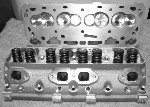Wally Kirstein sent me what I am convinced is an original F-Code cam as described in the manual. It is quite different than the over the counter cams that were sold as B7A6250C.
Here are the Cam Doctor specs:
EDB CAM
--------------------------------------------------------------------------------
CAM PRO PLUS Cam Lift Report 8/22/2010
--------------------------------------------------------------------------------
INTAKE
LIFT DUR. OPEN CLOSE AREA
Lobe I8 ----- ------ ----------- ----------- ------
Centerline 111.36 ATDC 0.001 439.18 103.61 BTDC 155.58 ABDC 24.61
.050 Lift C/L 111.40 ATDC 0.003 422.93 94.59 BTDC 148.34 ABDC 24.60
Runout 0.00080 0.006 402.52 84.27 BTDC 138.25 ABDC 24.55
Peak Open Acc. 0.000351 0.010 373.34 69.33 BTDC 124.01 ABDC 24.43
Peak Nose Acc.-0.000184 0.012 347.36 55.19 BTDC 112.17 ABDC 24.28
Peak Close Acc. 0.000299 0.015 307.96 36.39 BTDC 91.57 ABDC 24.03
Lift @ TDC 0.0629 0.018 283.34 26.91 BTDC 76.42 ABDC 23.81
Valve Lash 0.0180 0.019 278.63 25.56 BTDC 73.07 ABDC 23.76
Rocker Ratio 1.54 0.020 275.15 24.32 BTDC 70.84 ABDC 23.73
Lobe Separation ----- 0.050 233.46 5.32 BTDC 48.13 ABDC 23.03
Minimum Flat 0.100 196.55 12.92 ATDC 29.47 ABDC 21.72
Follower Dia. 0.7121 0.150 163.96 29.22 ATDC 13.18 ABDC 19.53
0.200 128.66 46.93 ATDC 4.41 BBDC 16.58
0.225 108.09 57.21 ATDC 14.70 BBDC 14.16
0.250 83.24 69.71 ATDC 27.05 BBDC 11.18
0.275 47.53 87.59 ATDC 44.87 BBDC 6.45
0.28707 --- PEAK CAM LIFT ---
0.42409 --- PEAK VALVE LIFT ---
EXHAUST
LIFT DUR. OPEN CLOSE AREA
Lobe E8 ----- ------ ----------- ----------- ------
Centerline 107.36 BTDC 0.001 442.45 138.90 BBDC 123.54 ATDC 24.88
.050 Lift C/L 106.98 BTDC 0.003 425.83 131.68 BBDC 114.15 ATDC 24.86
Runout 0.00030 0.006 405.15 121.46 BBDC 103.69 ATDC 24.82
Peak Open Acc. 0.000345 0.010 376.02 105.70 BBDC 90.32 ATDC 24.69
Peak Nose Acc.-0.000201 0.012 354.71 92.33 BBDC 82.38 ATDC 24.57
Peak Close Acc. 0.000294 0.015 318.52 74.98 BBDC 63.54 ATDC 24.34
Lift @ TDC 0.0746 0.018 291.61 65.62 BBDC 46.00 ATDC 24.12
Valve Lash 0.0180 0.019 284.81 64.16 BBDC 40.65 ATDC 24.04
Rocker Ratio 1.54 0.020 279.24 62.88 BBDC 36.36 ATDC 23.98
Lobe Separation ----- 0.050 234.35 44.15 BBDC 10.20 ATDC 23.24
Minimum Flat 0.100 197.31 26.05 BBDC 8.73 BTDC 21.92
Follower Dia. 0.7141 0.150 165.00 9.89 BBDC 24.89 BTDC 19.90
0.200 129.90 7.71 ABDC 42.39 BTDC 16.82
0.225 109.57 17.89 ABDC 52.54 BTDC 14.66
0.250 85.29 29.96 ABDC 64.75 BTDC 11.77
0.275 50.97 47.14 ABDC 81.89 BTDC 6.97
0.28895 --- PEAK CAM LIFT ---
0.42699 --- PEAK VALVE LIFT ---
http://ford-y-block.com 20 miles east of San Diego, 20 miles north of Mexico
